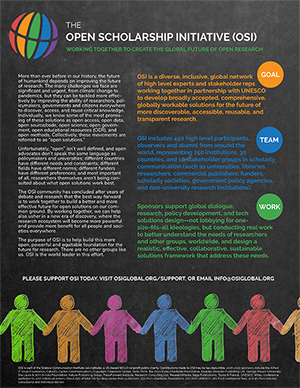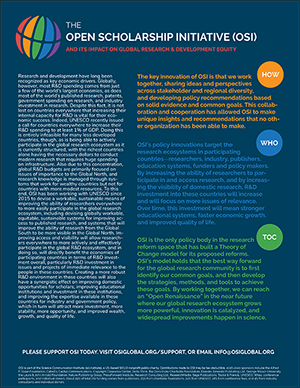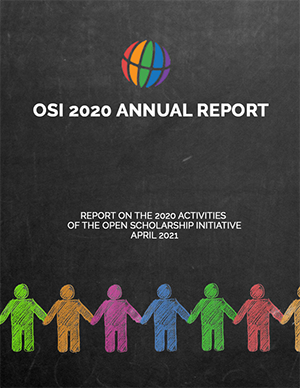


The goals of OSI are:
The eventual outcomes of this effort will include:
OSI is a 10-year-long effort. Because the scholarly communication stakeholder community is coming at this issue from so many different directions, the first step in our journey has been to acknowledge and value where each stakeholder group is in the process. This stage of OSI took place during 2016 and 2017. The next two years, 2018 and 2019, will involve figuring out what course adjustments can be made to the system to continue to improve scholarly communication and what assistance this community can offer—new incentives, coordinated policies, collaboration efforts, formal partnerships, new studies, pilot products, expanded perceptions, and so on. Our hope is that by 2020 the OSI group will be fully engaged in significant reform efforts, fine-tuning these efforts until 2025

No single actor in a multi-stakeholder system like this can enact system-wide change unilaterally; a mechanism for collaborative action needs to exist but it doesn’t currently exist in scholarly communication on a broad scale. Therefore, OSI has been designed to work on this change collaboratively and deliberatively, in a way that involves input from all stakeholders in the scholarly communications community, and always with an acute awareness that the new world of scholarly communication being designed needs to be accepted by the research community and be of benefit to this community, needs to work in every country, institution and field of study, and needs to be reliable and effective over the long term.
It is at these intersections of idealism and reality, of open knowledge and intellectual property, and of politics and policy that OSI’s most important work will be done—-determining the best balance point between embargoes and immediate release, designing data repositories that scientists actually want and will use, curbing the unintended consequences of publish or perish without dismissing the importance of publishing in academia, improving access to scholarship for underserved regions of the world without unintentionally making the access problem worse, and more.
Scholarly communication is changing and this change presents opportunities and challenges. Some of the change that is happening involves shaking up the current system to utilize publishing tools and approaches that may be better suited to an Internet-based information world. But not all current and needed changes fall into this category. Indeed, some of the most needed changes do not. The general guidelines for action as defined by the OSI2016 group are as follows:
The most important communication instruments OSI has been using in this process are: